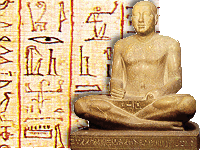
The word paper comes from papyrus, the reed that grows on the bank of the river Nile. To make paper, the
 Egyptians peels the outer layer off the reeds. The pith inside the stems was cut into strips, soaked in water and then placed in crisscross layers. These were hammered until they were squashed together. The surface of the papyrus was then soothed out with a wooden tool. Other writing materials included fragments of pottery, leather, and plastered boards.
Egyptians peels the outer layer off the reeds. The pith inside the stems was cut into strips, soaked in water and then placed in crisscross layers. These were hammered until they were squashed together. The surface of the papyrus was then soothed out with a wooden tool. Other writing materials included fragments of pottery, leather, and plastered boards. It is thought that only about four out of every 1,000 Egyptians could read or write. Scribes were professional writers who would copy out official records and documents, letters, poems and stories. The training of young scribes was thorough, strict and harsh. One teacher, Amenemope, wrote to his students, "pass no day in idleness or you will be beaten". However, most workers envied the scribes for their easy way of life. The were well rewarded for their work.
It is thought that only about four out of every 1,000 Egyptians could read or write. Scribes were professional writers who would copy out official records and documents, letters, poems and stories. The training of young scribes was thorough, strict and harsh. One teacher, Amenemope, wrote to his students, "pass no day in idleness or you will be beaten". However, most workers envied the scribes for their easy way of life. The were well rewarded for their work.
 providing detailed information about their lives can be found on everything from obelisks to tombs. From about 3100 B.C. they used pictures called hieroglyphs. Each of these could stand and object, and idea or sound. There were originally around 1,000 hieroglyphic symbols.
providing detailed information about their lives can be found on everything from obelisks to tombs. From about 3100 B.C. they used pictures called hieroglyphs. Each of these could stand and object, and idea or sound. There were originally around 1,000 hieroglyphic symbols.Hieroglyphs were used for thousands of years, but from 1780 B.C. a script called hieratic was also popular. Yet another script, demotic, was used as well as hieroglyphs in latter days of ancient Egypt.
However, by 600 A.D., long after the last of the pharaohs, no one understood hieroglyphs. The secrets of ancient Egypt were lost for 1,200 years, until the discovery of the Rosetta Stone.
 |
| Hieroplyphs were made up of small pictures. |
| Hieriatic script took the picture symbols of hieroglyphs and turned them into shapes that were more like letters. |
| Demotic script was introduced toward the end of the Late Kingdom. |
| The Rosetta Stone had hieroglyphs text at the top, demotic tex in the center, and Greek writing at the bottom. |
